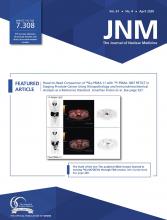REPLY: We would like to thank Dr. Sabour for taking an interest in our article, which highlights the potential diagnostic and prognostic utility of PET in patients after cardiac transplantation with known or suspected cardiac allograft vasculopathy (CAV) (1). As discussed by Dr. Sabour (2), there are additional test characteristics that need to be considered before routine implementation of a diagnostic test into clinical practice.
Several previous studies have established the precision and accuracy of PET myocardial blood flow (MBF) measurements (3–10). MBF measurements demonstrate excellent repeatability across serial studies, with repeatability coefficients of 0.19 mL/min/g for rest MBF and 0.92 mL/min/g for stress MBF (5). Measurements obtained with different radiotracers demonstrate very close correlation (r = 0.85 to 0.92) (8,9). Additionally, the RUBY-10 study demonstrated excellent agreement between global and regional MBF measurements determined with 10 different software packages (3). As a result of this substantial body of evidence, guidelines recognize PET measurements of MBF and myocardial flow reserve as highly accurate and precise measurements (11).
Dr. Sabour also accurately points out that no single measure of a diagnostic test accurately reflects all aspects of its clinical performance. Table 1 contains additional measures of diagnostic accuracy. Stress MBF < 3.7 has the highest negative predictive value (95.0%), whereas the combination of left ventricular ejection fraction < 45% and myocardial flow reserve < 1.75 had 100.0% positive predictive value. Notably, the prevalence of CAV varies with time after cardiac transplantation, which will also influence test characteristics (12). The median time after transplantation was 12.5 y in our cohort, so the results are most applicable to screening patients late after transplantation.
Summary of Test Characteristics for Identifying CAV Grade 2 or 3
Lastly, we would like to clarify that in our study we tested previously established thresholds for PET measurements in transplantation patients in a population distinct from previous similar studies. Therefore, our results demonstrate generalizability of the diagnostic accuracy of PET across patient populations as well as providing valuable external validation of the prognostic utility. Our article contributes to a robust body of literature outlining the potential superiority of PET for CAV surveillance (13), and cardiac transplantation programs should strongly consider its implementation.
DISCLOSURE
The work was supported in part by the Dr. Miriam and Sheldon Adelson Medical Research Foundation. Dr. Miller receives funding support from the Arthur J E Child Fellowship grant. Drs. Berman, and Slomka participate in software royalties for QPS software at Cedars-Sinai Medical Center. No other potential conflict of interest relevant to this article was reported.
Footnotes
Published online Oct. 10, 2019.
- © 2020 by the Society of Nuclear Medicine and Molecular Imaging.







